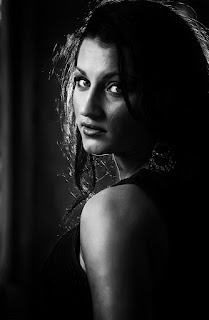 Here is one photograph from the shoot where a combination of using onsite speedlights, a stunning model, and some simple post processing created a dramatic portrait. The shooting conditions were somewhat difficult with broken clouds accented with a bright sun. Shooting in anything except a full shade was pretty much out of the question.
Here is one photograph from the shoot where a combination of using onsite speedlights, a stunning model, and some simple post processing created a dramatic portrait. The shooting conditions were somewhat difficult with broken clouds accented with a bright sun. Shooting in anything except a full shade was pretty much out of the question.
The setup for this image was rather simple. It was shot in the shade of porch area using two speedlights fired remotely. On the key light was attached a 24x30 softbox and it's power setting was reduced to about 1/4 power. It was placed about 4 feet from the model at somewhere between 90 and 60 degrees inline with the head and was adjusted to just above eye level. This allowed the softbox to extend slightly above and below the models head and shoulders and to also provide some soft wrap around light. Behind the model about 10 feet away another speedlight was setup dialed down to about 1/8th power. It was a bare light raised to about head level and pointed directly and the model.
It was shot on manual set at ISO 100 at f/9 at 1/200th with the lens zoomed out to 200mm. This setting produced a well exposed portrait with a sharp drop off of contrast and some wrap around from the key light and nice separation highlights on the hair from the second light.
Post processing included convertion to black and white using a film noir process which generated a dramatic contrast without blowing out the highlights. The midtones were dropped to darken the background and the resulting image became a stunning example of how artificial light can be used to make a natural looking, yet powerful portrait...even in daylight.



